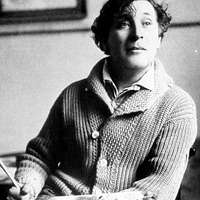The Russian born Jewish artist who spent most of his life in Europe could claim various allegiances. But his own experience of war, and its influence on his art, proves otherwise.
“But there is one thing I will tell you: Although I was born in Russia – and what is more: in the ‘settlement territory’ – I was trained abroad and am all the more sensitive to everything that is taking place here.”
As quoted in Vitali’s The Russian Years 1906-1922, this is what early modernist artist Marc Chagall wrote in a letter regarding his art career. But given today’s tensions between Russia and the West, it’s not difficult to imagine a Belorussian immigrant voicing similar feelings. What would Chagall himself have thought?
The famous artist would have certainly found himself at an interesting crossroads. Born to a Jewish family in 1887 in the Russian Empire, he spent large portions of his life in the West, and had to flee the rise of Fascism in Europe. In 1973, The National Museum of Marc Chagall was inaugurated on his birthday in the French Riviera city of Nice, a popular holiday destination for wealthy Russians that still hosts a large Russian community. Today, the world power that ruled over his native lands wages war against Ukraine in the name of denazifying its former Soviet territory.
As a Russian born Jewish artist who spent most of his life in Europe, he could claim various national allegiances. But his life experiences and witnessing of the violence that ripped Europe apart in the first half of the twentieth century—which make obvious and metaphorical appearances in his later artwork—might beg to differ.
Two Wars and a Revolution
Marc Chagall was born as Moishe Segal in Vitebsk (today found in Belarus), a historically Jewish town. It was through local painter Jehuda Pen that he was first exposed to art—the passion that would guide him to Saint Petersburg, then to Paris, and then to his first solo show in 1914 Berlin. After his show, he ignored the rumors of war and returned to Vitebsk. He was thus stranded in his hometown when World War I broke out.
He was also in Vitebsk during the Russian Revolution of 1917 that finally gave the Russian Jewish population citizenship, but eventually returned to Paris in 1923 to take up printmaking and book illustration projects, including one for the Bible which he completed after a trip to Palestine.
After the start of World War II less than two decades later, Chagall and his family fled to New York City in America, where he joined the local artist refugee community. By the end of the war, he had become a well known art master. After the war, Chagall moved back to France and ultimately settled in the French Riviera.
Art of War
Chagall’s work was greatly influenced by his indirect experience of these conflicts, particularly World War II. The rise of Hitler saw a stark change in Chagal’s painted subjects, like his White Crucifixion (1938), in which viewers observe a pale and crucified Christ in the middle of the painting, with chaos unfolding all around him in whites, grays, and the occasional sharp colors. His use of biblical scenes like the crucifixion of Jesus clearly represents the suffering of the Jewish people in the face of rampant anti-semitism.
Similarly, in his Obsession (1943), Jews flee a burning house in the back of a cart, while a crucified Jesus lies just beyond. But perhaps the most obvious painting is that which he titled simply War (1964): a dark setting contrasted by blazing flames destroys a village as its inhabitants flee, once again, on the back of a cart. Some remain trapped in the village, and are devoured by the fires.
It was the same Chagall who allegedly said, “If a symbol should be discovered in a painting of mine, it was not my intention. It is a result I did not seek. It is something that may be found afterwards, and which can be interpreted according to taste.” And yet it’s hard to not recognize a continuity to all the fleeing folks, all the crucified Jesuses, and all the bright, devouring flames that emerged in his work after the second world war.
Chagall and the Ukraine War
So what would Marc Chagall have thought of the Russia-Ukraine war waged by his motherland on behalf of the ethnically Russian Ukrainians suffering at the hand of a supposedly neo-fascist Ukrainian government?
Some critics believe his White Crucifixion was also a critique of Stalin, under whom the Holodomor starved almost four million Ukranians. Surely Chagall would have seen the fleeing figures in his paintings in the wave of Ukrainian immigrants, and seen past Putin’s denazification claim as justification for the war he started on February 24th, 2022.
In fact, in the early 1940s, Chagall painted a lesser known masterpiece, La Famille Ukrainienne (1940-43), which depicts a family fleeing yet another burning village. A ghastly lamentation of the country’s past, and a chilling prediction of its future.
Margherita Bassi
*Ce travail a fait l’objet d’une vérification juridique et éditoriale par Zoe Jones et Lucie Guerra*



